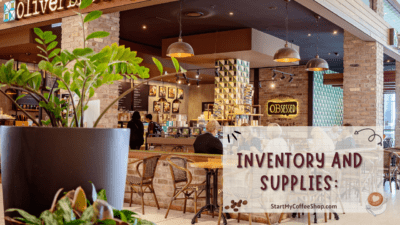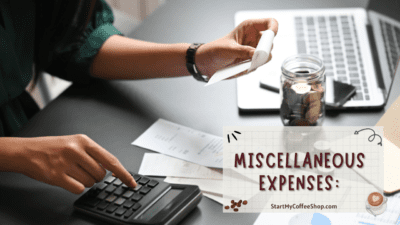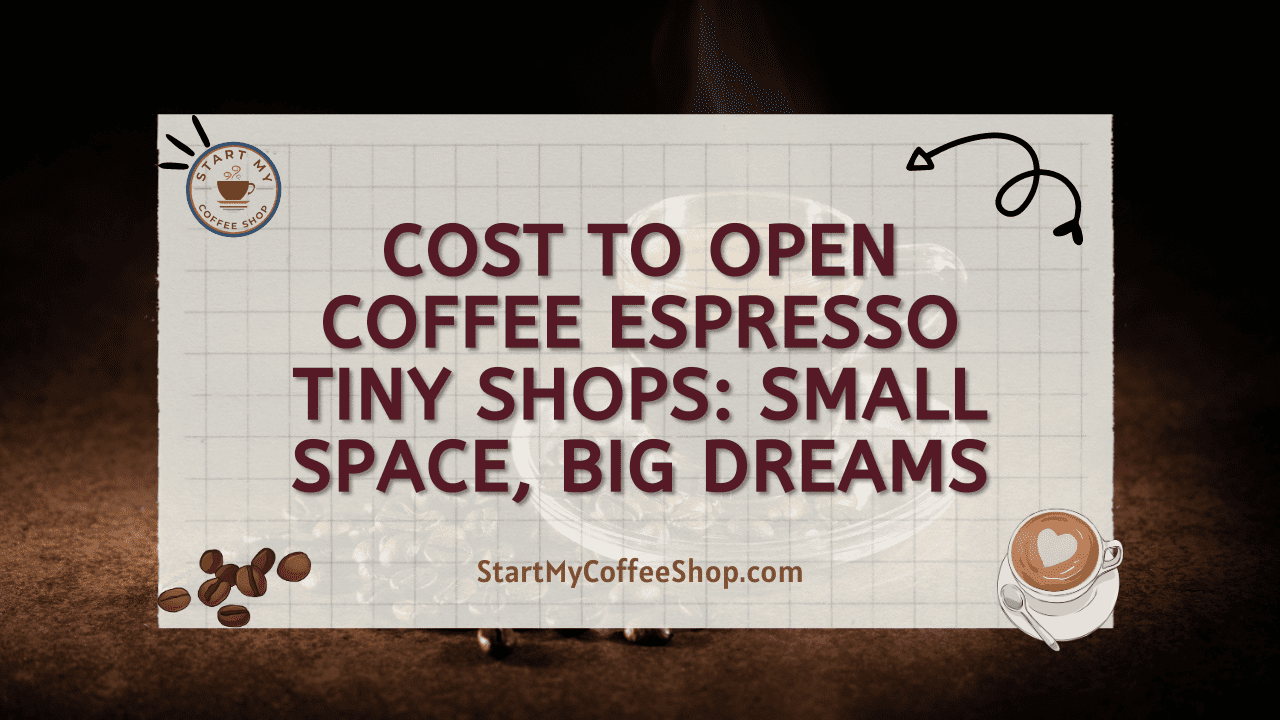In recent years, the rise of specialty coffee and the demand for unique coffee experiences have fueled the growth of small, cozy coffee espresso shops. These intimate spaces, often referred to as “tiny coffee shops,” offer a personalized and artisanal approach to coffee brewing.
The cost to open a coffee espresso tiny shop can be affected by factors like rent, renovations, equipment, licenses, inventory, marketing, staffing, and miscellaneous expenses. Creating a wise budget is recommended.
In this article, I will delve into the various expenses involved in launching a great coffee shop of this nature and provide insights to help you navigate the financial aspects of your venture.
Location and Rent:
When it comes to opening a tiny coffee espresso shop, the importance of finding the perfect location cannot be overstated. The cost of rent is a major consideration that varies based on several factors.
The city, neighborhood, and size of the space all play a significant role in determining rental prices. In bustling urban areas with high demand, it’s common to encounter higher rents compared to smaller towns that may offer more affordable options.
Aside from the location itself, there are other important factors to consider. Foot traffic is crucial for attracting customers, so areas with heavy pedestrian flow are desirable. The presence of nearby businesses can also contribute to increased visibility and potential customer base.
On average, monthly rent for a tiny coffee espresso shop typically falls within the range of $1,500 to $5,000. However, it’s important to note that this figure can fluctuate significantly depending on the specific location and its associated market conditions.
Proper research and analysis of the local rental market will help you make an informed decision and budget accordingly for this vital expense.
Renovations and Equipment:
When embarking on the journey of transforming a space into a cozy coffee shop, it’s important to allocate funds for renovations and equipment. Renovations typically involve creating an inviting atmosphere by installing a counter, shelves, seating areas, and a designated brewing station.
The cost of remodeling will vary depending on the extent of renovations required and the size of the space. It’s crucial to carefully plan and budget for these expenses.
Equally important is investing in high-quality equipment to ensure a smooth and efficient coffee-making process. The essential equipment includes an espresso machine, coffee grinders, brewing equipment, refrigeration units for milk storage, and small kitchen appliances.
The price range for such equipment can be substantial, with costs ranging from $10,000 to $30,000 or more, depending on your specific needs and preferences. While it may seem like a significant investment, quality equipment is essential for delivering exceptional coffee and creating a positive customer experience.
Licenses, Permits, and Registrations:
When it comes to operating a coffee business, ensuring legal compliance is paramount, and this entails obtaining the required licenses, permits, and registrations. The specific requirements can vary depending on your location, so thorough research and adherence to local regulations are crucial.
Common permits typically include health permits, which ensure that your shop meets sanitary standards, food service licenses to serve food and beverages, and business registrations to establish your coffee business as a legal entity.
The costs associated with obtaining licenses and permits can vary significantly based on your area and the specific permits required. Generally, fees can range from a few hundred to a few thousand dollars.
It’s important to consider this expense when budgeting for your coffee shop venture. Additionally, the application process may involve certain prerequisites, inspections, and documentation, so it’s advisable to allow sufficient time and be well-prepared to meet the requirements.
To ensure a smooth and legal operation of your coffee shop, consult with local authorities, such as health departments and business licensing offices, to understand the specific permits and licenses you need and the associated costs.
Complying with these regulations not only demonstrates your commitment to providing a safe and compliant environment but also helps build trust with customers and establish a solid foundation for your coffee business.
Inventory and Supplies:

Delivering exceptional coffee to your customers requires sourcing high-quality ingredients such as coffee beans, milk, syrups, and other necessary items. Building strong relationships with local suppliers is crucial as it allows you to maintain freshness and offer unique flavors in your coffee creations. When considering the cost of inventory, it’s important to factor in both the initial purchase and ongoing expenses for restocking.
Calculating the initial inventory cost involves estimating the quantities needed to start your coffee shop and the associated prices of each item. Additionally, consider the variety of coffee beans you plan to offer, the types of milk and syrups, and any additional ingredients for specialty drinks or menu items. As you determine the appropriate inventory levels, it’s essential to strike a balance between having enough stock to meet customer demand and minimizing waste.
Monthly inventory costs can vary significantly depending on the size of your shop and the complexity of your menu offerings. On average, you can expect inventory expenses to range from $500 to $2,000 or more. However, these figures are approximate and subject to change based on your specific business model, customer demand, and pricing strategy.
Regularly evaluating your inventory levels and monitoring customer preferences will help you fine-tune your ordering process and minimize waste. By establishing efficient inventory management practices, you can ensure that your coffee shop consistently offers fresh and high-quality products while optimizing costs and maintaining profitability.
Read more about Best Coffee Shop Counter Design: Designing the Ideal Counter
Marketing and Branding:
In the competitive coffee industry, effective marketing and branding play a pivotal role in attracting customers and establishing your coffee shop’s presence. Allocating funds for marketing efforts is essential to create awareness, build a strong brand identity, and drive customer engagement. A well-executed marketing strategy can include various components, each with its associated costs.
Creating a visually appealing logo and signage is crucial for brand recognition. Hiring a professional designer to craft a captivating logo and design eye-catching signage may incur costs, but it is a worthwhile investment. Developing a website is another key element in today’s digital landscape. Costs can vary depending on the complexity of the website and whether you hire a web developer or utilize a DIY platform.
Engaging in social media campaigns is an effective way to reach a broader audience and foster customer engagement. While social media platforms offer free access, allocating a budget for targeted advertisements and content promotion can enhance visibility and generate measurable results. Furthermore, advertising in local publications or online platforms can help target specific demographics and geographic areas, though costs will depend on the advertising medium and its reach.
As for budgeting, a general guideline is to allocate 5-10% of your projected annual revenue toward marketing. However, it’s essential to consider your specific goals, market dynamics, and competition to determine an appropriate budget for your coffee shop.
Staffing and Training:
While a tiny coffee espresso shop may not require a large workforce, hiring and training competent and friendly staff is crucial to delivering an exceptional customer experience. Consider the daily operational needs of your shop, including roles such as baristas, kitchen staff, and cleaning personnel. Determining the appropriate number of employees will depend on factors such as the size of your shop, expected customer volume, and the complexity of your menu.
When budgeting for staff, it’s important to consider labor costs, which encompass wages, benefits, and payroll taxes. Labor costs can vary based on your location and the number of staff members you employ. Researching industry standards and local labor laws will help you determine fair compensation for your employees.
Compliance with labor laws is paramount to ensure a legal and ethical work environment. This includes adhering to minimum wage requirements, providing necessary breaks, and maintaining accurate employee records. Additionally, offering benefits such as health insurance or retirement plans may be considered to attract and retain skilled staff members.
Investing in staff training is also crucial. Properly trained employees can deliver consistent and high-quality service, enhancing customer satisfaction and loyalty. Training programs should focus on coffee preparation techniques, customer service skills, and hygiene practices.
Remember, creating a positive work environment with fair compensation and ongoing training opportunities will contribute to employee satisfaction and motivation. Happy employees are more likely to provide exceptional customer service, leading to a thriving coffee shop.
Miscellaneous Expenses:

In addition to the previously mentioned costs, there are several miscellaneous expenses that should be taken into account when opening a tiny coffee espresso shop. These expenses encompass a wide range of items necessary for the day-to-day operations of your business.
Utility costs are an essential consideration, including expenses for electricity, water, and internet services. These costs will vary depending on the size of your shop, the equipment used, and the local rates. It is important to estimate these expenses accurately to avoid any surprises on your monthly bills.
Insurance coverage is another crucial aspect to protect your coffee shop and its assets. General liability insurance safeguards your business against potential lawsuits, while property insurance provides coverage for damage to your premises and equipment.
Workers’ compensation insurance is necessary if you have employees, as it protects both your staff and your business in the event of work-related injuries or illnesses. The specific costs for insurance coverage will depend on factors such as the size of your shop, location, and coverage limits.
Investing in a reliable and efficient point-of-sale (POS) system is vital for smooth transactions and effective management of your coffee shop. POS systems can range in cost depending on the features and capabilities they offer. It’s important to choose a system that suits the needs of your business and can handle tasks such as processing payments, inventory management, and sales reporting.
Packaging costs should also be considered if you plan to offer takeout or delivery options. This includes items like cups, lids, sleeves, bags, and other packaging materials. Properly budgeting for packaging costs ensures that you can provide a professional and convenient experience for customers who prefer to enjoy their coffee on the go.
Additionally, you should account for cleaning supplies to maintain a clean and sanitary environment. This includes items such as detergents, sanitizers, trash bags, and restroom supplies. These expenses are essential for upholding health and safety standards.
Lastly, maintenance costs should be factored into your budget. Regular maintenance and occasional repairs of equipment, furniture, and fixtures are necessary to keep your coffee shop running smoothly and ensure a pleasant experience for customers.
Read more about Best French Press Coffee Makers: The Quest for the Perfect Cup
Conclusion:
Opening a tiny coffee espresso shop is an exciting venture, but it requires careful financial planning and consideration of various expenses. From securing the perfect location to investing in equipment, licenses, and marketing efforts, there are multiple cost factors to evaluate. Remember that costs can vary based on your specific circumstances, location, and goals.
You can embark on your coffee entrepreneurial journey with confidence by understanding the expenses involved, conducting thorough research, and creating a realistic budget. So, brew your dreams, savor the journey, and create a warm and inviting haven for coffee enthusiasts to gather and enjoy their daily cup of happiness.
Frequently Asked Questions
What is the average cost of rent for a tiny coffee espresso shop?
Rent costs can range from $1,500 to $5,000 per month, depending on the location, size, and foot traffic of the shop.
How much should I budget for renovations and equipment?
Renovation costs will vary but be prepared to invest in counter installations, seating areas, and brewing stations.
What licenses and permits do I need to open a coffee shop?
Common permits include health permits, food service licenses, and business registrations.
Read more about
To learn more on how to start your own coffee shop checkout my startup documents here
Please note: This blog post is for educational purposes only and does not constitute legal advice. Please consult a legal expert to address your specific needs.

Hi! I’m Shawn Chun
My adventure in coffee began when I first launched my first coffee shop back in the early 2000s. I had to figure out so many things on my own and to make it worse within 2 years of opening two large corporate coffee chains moved in just blocks away from me!
As I saw smaller and even some larger coffee shops in the neighborhood slowly lose customers to these giant coffee chains and slowly close up shop, I knew that I had to start getting creative…or go out of business.
I (like you may be) knew the coffee industry well. I could make the best latte art around and the foam on my caps was the fluffiest you have ever seen. I even had the best state-of-the-art 2 group digital Nuova Simonelli machine money could buy. But I knew that these things alone would not be enough to lure customers away from the name brand established coffee shops.
Eventually, through lots of trial and error as well as perseverance and creativity I did find a way to not only survive but also thrive in the coffee/espresso industry even while those corporate coffee chains stayed put. During those years I learned to adapt and always faced new challenges. It was not always easy, however, in the end, I was the sole survivor independent coffee shop within a 10-mile radius of my location. Just two corporate coffee chains and I were left after that year. All told the corporate coffee chains took down over 15 small independent coffee shops and kiosks and I was the last one standing and thriving.
Along the years I meet others with the same passion for coffee and I quickly learned that it is not only “how good a barista is” that makes a coffee shop successful, but the business side of coffee as well.
Hence why I started this website you are on now. To provide the tools and resources for up and coming coffee shop owners to gain that vital insight and knowledge on how to start a coffee shop successfully.
Stick around, browse through my helpful blog and resources and enjoy your stay! With lots of LATTE LOVE!
Shawn







